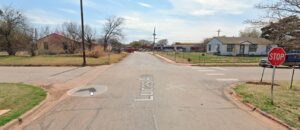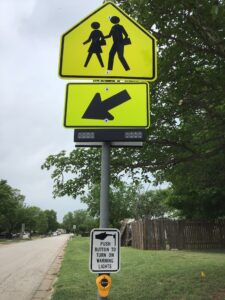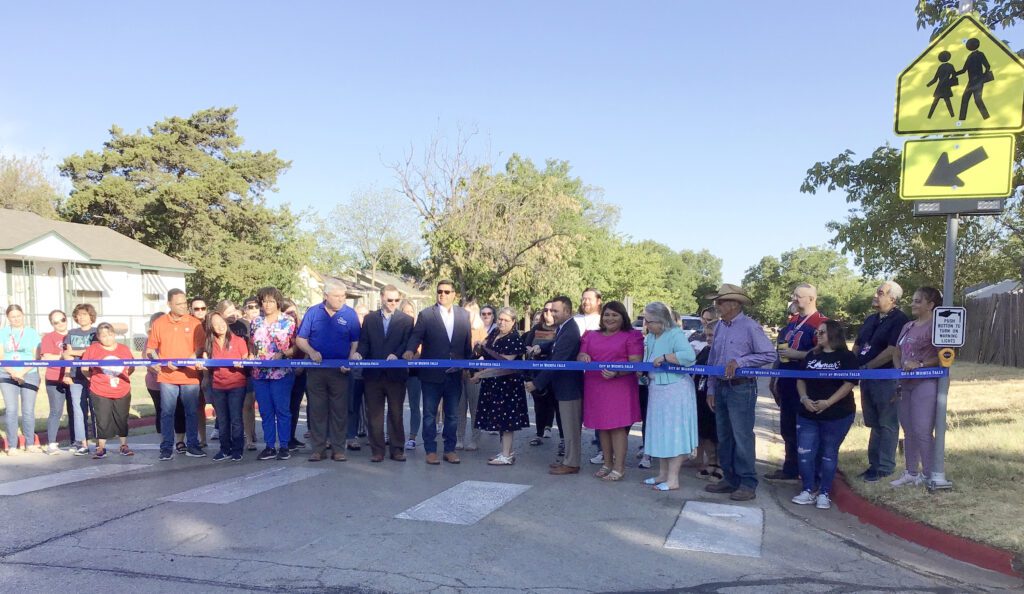Location: Wichita Falls, Texas
Project size: 1 x R920-E RRFB crosswalk system
Client: City of Wichita Falls / Wichita Co. Public Health District
Background
Walking is a fundamental part of life in Wichita Falls, Texas, a city of more than 100,000 located just south of the Oklahoma border. Children walk to school, adults walk to work, and people of all backgrounds and abilities walk to accomplish their daily errands and exercise.
And yet, as in cities across North America, walking in Wichita Falls can be a dangerous activity. According to the city’s Metropolitan Transportation Plan, between 2014 and 2018, there were 96 crashes involving pedestrians. Nine of them were fatal.
While the city has in recent years redoubled efforts to improve safety and promote walking as a safe, sustainable mode of transportation—including paving a 24-mile shared-use trail that circles Wichita Falls—much work remains. This is particularly true in low-income neighbourhoods, as well as near schools and parks.
Project requirements
The Sunnyside subdivision on the city’s southeast side is one such area where pedestrian infrastructure is severely lacking. It includes Lamar Elementary and the neighboring Lamar Park, which together generate a significant volume of pedestrians (according to Lamar Elementary principal Amanda Garcia, more than half of the school’s 420 students walk to school most of the time).

Despite this, there is just one sidewalk in the entire subdivision: a half-mile stretch along Hines Boulevard and Lucas Avenue. This leaves students and park users with only one safe path, forcing those traveling from other directions to walk on the road and/or jaywalk across busy, high-speed streets.
Even the marked crosswalk at the intersection of Hines and Lucas is unsafe. There are only two stop signs, and these are on Lucas and not Hines, where the crosswalk is located. The crosswalk paint is faded, signage is easily obscured by trees and parked cars, and there is just one curb ramp, which itself is too narrow to accommodate pedestrians with disabilities.
To make matters worse, many drivers do not adhere to posted school zone speed limit signs, or drive “erratically” outside these times, according to residents. “Children are crossing the street, but cars are passing way too fast for the children to be walking or crossing the street in a safe manner,” said one resident. Signs prohibiting cell phone use while driving are also routinely ignored.

Our solution
For the reasons above, the crosswalk at Hines and Lucas was a prime candidate for Carmanah’s best-selling rectangular rapid-flashing beacons (RRFBs)—high-intensity, pedestrian-actuated light bars that flash to alert drivers to crossing pedestrians. The ultra-bright LED lights and erratic flash pattern have proven to capture drivers’ attention and increase yield rates in all types of weather and light conditions.
As part of a first-time partnership between Carmanah and America Walks, a pair of Carmanah RRFBs was awarded to the City of Wichita Falls. Carmanah worked with the city to install two low-cost R-920-E solar-powered RRFBs, which were determined to be suitable for the location based on the results of a Solar Power Report (SPR).
Each of the RRFBs includes a compact solar panel and energy management system (EMS), reflective sign, amber LED light bar, and ADA-compliant iNX pushbutton. “The great thing about the R920-E is how much it can do with so little,” says Carmanah Business Development Manager Jesse Fraser. “We recently upgraded the solar panel to 15 watts, meaning it can power components like the iNX pushbutton without needing to move up to a larger system. This helps keeps costs down, allowing agencies to get more mileage from their safety budgets.”
Outcome
The new RRFBs were installed in May 2022 and already their impact on the safety of the community is being felt.
“As the principal, my first job is to ensure the safety of all students and staff,” said Principal Garcia. “Sending them home, I’m able to have more peace and comfort because I know that an extra measure has been put into place for their overall safety.”
